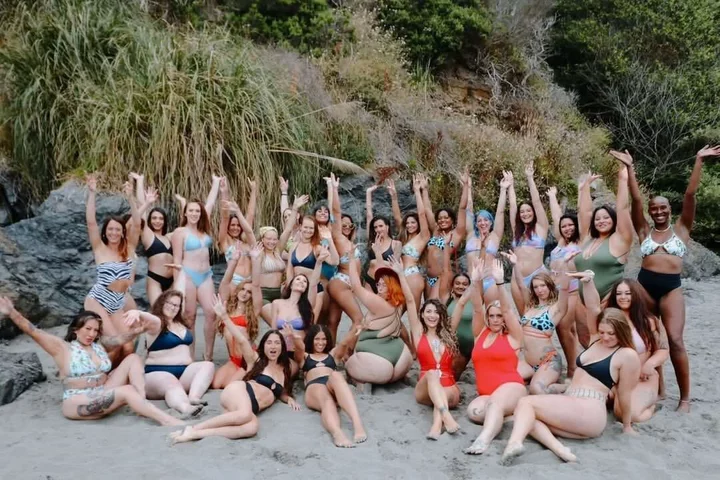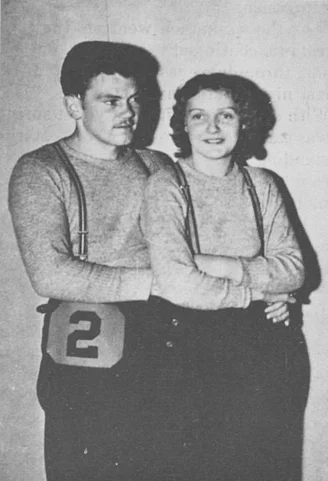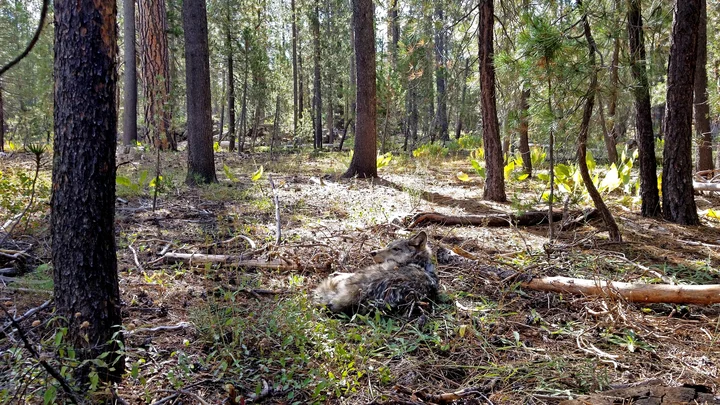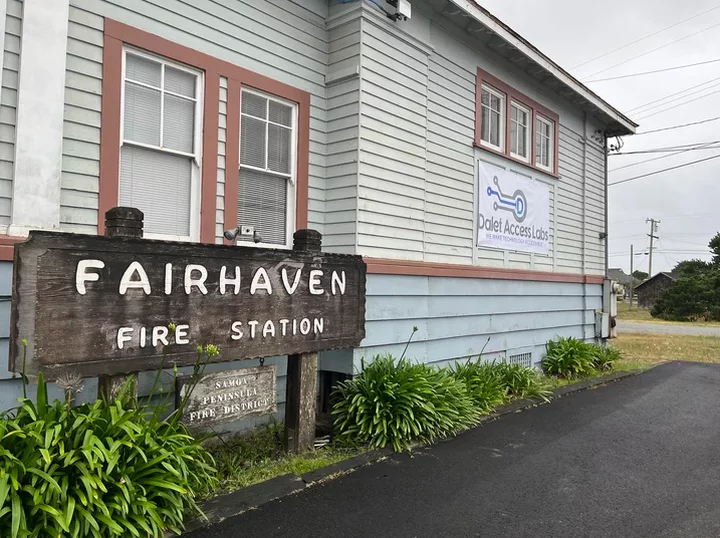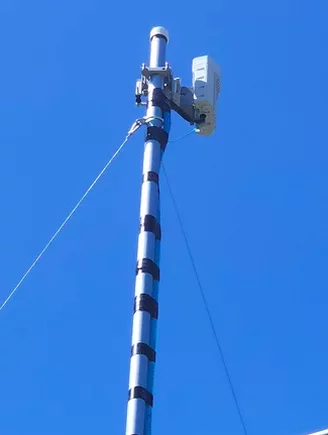THE ECONEWS REPORT: Suing the Feds for Klamath Water
LoCO Staff / Saturday, April 15, 2023 @ 10 a.m. / Environment
Photo: Blake, Tupper Ansel, U.S. Fish and Wildlife Service, via Wikimedia. Public domain.
Despite the wildly wet year, the Bureau of Reclamation has threatened to reduce flows in the Klamath River below the mandatory minimum for salmon. Such an action will dry up critical habitat for salmon at a time when salmon populations are critically low. Now, the Yurok Tribe and fishermen are in court together to challenge the low flows.
Amy Cordalis, legal counsel for the Yurok Tribe and a tribal member, and Glenn Spain, executive director of the Pacific Coast Federation of Fishermen’s Association join the show to discuss their new litigation and other issues imperiling salmon runs in the Klamath River.
REQUIRED READING:
BOOKED
Today: 6 felonies, 14 misdemeanors, 0 infractions
JUDGED
Humboldt County Superior Court Calendar: Today
CHP REPORTS
North Rd / Hoiland Rd (HM office): Live or Dead Animal
ELSEWHERE
KINS’s Talk Shop: Talkshop December 4th, 2025 – William Honsal
Washington Post: Oregon tribe harvests its first whale in generations
NPR: After federal funding cuts, tribal radio station says silence is not an option
NPR: Family of Colombian man killed in U.S. strike files human rights challenge
THE HUMBOLDT HUSTLE: A Swimwear Business? In Humboldt County? This Brazilian Expat is Making a Go of It With Fashion-Forward Designs and a Social Conscience
Eduardo Ruffcorn-Barragán / Saturday, April 15, 2023 @ 7:45 a.m. / The Humboldt Hustle
Lorena Alvez.
Swimwear is not what comes to mind when you think of Humboldt
fashion. We’re typically limited to rain gear, hiking gear and cozy
clothing, and it’s hard to picture someone wearing swimwear out on
our beaches. It’s hard to imagine that there is a market for
swimwear here.
But Lorena Alvez, 33, owns and operates On the Lo Swimwear here in Humboldt County.
Alvez founded the company in 2018 with a vision to create swimwear that is fashionable, inclusive and sustainable. Originally from Brazil, Alvez took the cheeky design of Brazilian swimwear and is making it accessible to as many bodies as possible.
“I try to tell ladies that it shouldn’t matter what a tag says,” Alvez says. “What matters is that it fits your body.”
Offering pieces in sizes ranging from XS to 2XL, she aims to change her size guide to be on a numbered system. This way, any implications that come with the typical sizing system are removed. Currently, Alvez markets her work on Instagram and sells it directly through her website.
“I struggled with body issues throughout my life, and my business not only has a creative aspect to it but it helps me empower myself and other people,” Alvez said.
Every anniversary for her business, Alvez invites local women to model her swimwear. Last year, nearly 30 women took part in this photo shoot.
Group shot! All photos courtesy Alvez.
“I see these ladies in all shapes and sizes celebrating each other and it’s powerful,” Alvez says. “I want inclusivity to also mean community.”
Alvez and her family immigrated to Boston when she was 7 years old. Being the oldest of three siblings, Alvez spent most of her upbringing in Boston and went to University of Massachusetts-Amherst for her undergraduate years. In that time she studied abroad in Argentina and Spain while earning her degrees in psychology and Spanish. Fatefully, she made a friend while abroad who was a student at Cal Poly Humboldt, formerly Humboldt State University.
After graduating, Alvez had to hustle just to pay her student loans. She held five jobs including bartending, nannying and being a personal assistant.
Eventually Alvez was convinced to take a week-long vacation by her friend to visit California. She landed in San Francisco for Pride 2013 and they drove their way up to the Redwood Curtain. After the week was done, Alvez called her mom to tell her she was not going back to the East Coast.
She fell in love with Humboldt, but still had to work day to day to pay her student loans. Throughout the next five years, working without any creativity began to wear on Alvez. Then, in 2017, she took a trip to Brazil to visit family. Her uncle had an idea to go to a seamstress to get custom speedos made, and asked if she wanted to tag along. It was here that Alvez designed her first bottoms and got the idea to start selling her designs back home in the United States.
She brought stock of her design back with her and sold them all on SnapChat and local markets quickly enough that she wanted to make more. In some cases, she would take her inventory to prospective buyers’ homes so they could try on the swimwear before buying it.
“I had customers asking me to design tops, so that’s when I said, ‘OK, I’m starting a business,’” Alvez says.
In the summer of 2018, Alvez took part in the Small Business Development Center (SBDC) Summer Entrepreneurship Program and it helped solidify her transition into a legit business. By 2019, Alvez began to make body suits and launched her website and online store. Then in 2020, she launched Unisex swimwear, speedos and boardshorts.
Alvez’ designs became popular so quickly that they were featured in the New York Fashion Week 2021. Alvez documented the entire thing here.
Though every piece is handmade, Alvez inventory grew large enough that she began to offer wholesale purchases. She also offers local customers the opportunity to visit her home studio to try on swimwear before they buy it.
Alvez hopes to partner with local businesses to sell her swimwear in-store, but she has not locked down a deal. This is part of the reason she started a website so quickly, especially for a business as small as hers.
“I had considered closing my business a few times but I love it so much,” Alvez says. “I always had side hustles to keep it alive.”
Unrelated to the swimwear, Alvez wants to focus on community engagement with things like the “Goddess Hike” she is advertising on Instagram for April 15. She also hopes to participate in giveaways with other brands and local businesses.
Looking ahead, Alvez established an LLC in Mexico with the intention to expand farther than Humboldt County. She also is determined to find a sustainable fabric to make her products better quality and to have more longevity than typical swimwear.
###
Got an interesting story about living the Humboldt Hustle? Email eddie@lostcoastoutpost.com. He’d love to hear it!
HUMBOLDT HISTORY: In the Midst of the Great Depression, Young People Would Gather at Fifth and Broadway and Walk in Circles Until They Dropped
Glen Nash / Saturday, April 15, 2023 @ 7:15 a.m. / History
During the year 1935, there were several events, some of which will be remembered around the world, this nation, and this county. The world was saddened by the deaths of Will Rogers and Wiley Post when they crashed in a plane in the frozen Arctic. Locally, this county was shocked by the drowning of Dr. Gilbert A. Howatt, a well-known dentist and civic leader of Eureka, and John Martin of Trinidad who lost his life while trying to save Dr. Howatt.
Then, there was the lumber and timber workers’ strike to unionize the local lumber mills, sparking riots and the shooting deaths of several workers at the entrance to Holmes Eureka Mill. There were other events, such as the National Boy Scout Jamboree which was to be held in Washington, D.C, when it was called off by President Franklin D. Roosevelt because of an infantile paralysis epidemic in that city. But the Boy Scouts substituted a train trip across the United States and 39 boys and their leaders from this area participated.
The amateur Walkathon Contest had invaded Eureka. The contests were being held all across the United States. The event was advertised in the local newspapers and on radio, inviting local young people to participate. All they had to do was to walk around until the last one remained standing.
The Eureka City Council and Eureka Mayor Frank Sweasey were very reluctant to grant a license for this event because some of the walkathons were encountering trouble elsewhere in the country. The council finally agreed upon a fee of $750 per month and a permit was granted. Originally this event was to be held in the old Occidental Pavilion at Second and A streets, but it was decided to hold it at the Broadway Arena at 120 W. Fifth St. The doors opened June 21, 1935, with twenty couples participating. The contest was sponsored by the local post of the V.F.W. It started off with a large crowd of spectators filling all the bleachers.
The arena also was used for boxing matches. Max Baer and Primo Camera appeared there, as well as Fieldbrook boxer. Tiny (Milton) Abbott, Buddy Baer, Archie Forson and Ival Wilson. The CCC all-amateur fights were held in the arena. The building also was used for dances and was called the “Cinderella Hall.” Many big bands played there and this writer attended a number of these events.
There were wood bleachers on all sides with a space in the center where the boxing ring was set up. This was taken out for the walkathon and a small stage provided for the band and announcer. One unique advertising stunt for the walkathon was a very large brown shepherd dog walking around town with an oilcloth sandwich board on his back advertising the “Walkathon.”
The dog attracted a lot of attention as it went about town each day. The dog belonged to Jack Mero, owner and operator of the Brown Dog Beer Parlor.
Once the walkathon started and got into full swing there were many special events each night to draw the spectators. These included fast sprints of ten minutes duration, in which the winning couple would win a prize of a few dollars. Each participant would be given a date which was celebrated as their birthday with a party. This would be advertised through publicity on local radio broadcasts from the arena.
On some nights various contestants would sing or dance or perform some act to help draw a crowd. During August there was a troupe of all-girl clowns called the “Morgan Family Clowns.” They were appearing at the Ferndale Fair and they were hired to put on a show for a few nights at the walkathon.
During the contest, if a contestant became too tired to continue or became sick, his or her partner would walk alone until some other contestant would be left alone and then they would join up to form a couple. These contestants were fed three times a day and three times a night with good food, some of which was donated by local restaurants. There was a nurse present at all times and she took care of minor aches and sore feet, rubbing affected areas with oil of wintergreen. There was a ten minute rest every hour when contestants could change clothes, take a shower or rest.
Dr. Stephen Fleming came whenever needed to check on participants and Dr. Sam Burre would come to help with medical problems. Every now and then one of the girls would pretend to faint and pass out and be carried off the floor. Later, she would appear and put on quite a show.
The day nurse’s name was Katherine Siegle. Her husband, Al Siegle, helped to run the show and was one of the organizers of the event.
A marriage was held one day for Ann Yost and Joe Rudd. It was a large ceremony, well advertised on radio, and a large crowd attended. A photographer took postcard-size pictures of the couples, and the photos were sold to spectators wanting a picture of a favorite couple. Every dollar counted in those days of the great depression.
As the walkathon went on, the contestants continued to drop out, one by one, through the last few days and the last night, Saturday, August 31, 1935. With only a few left, a very fast sprint was staged as long as someone was still standing. Finally, there was only one couple left, and they won the prize money of $1,000.
There are still some of the contestants around this county, and they tell me that Jack Hammond won the money. Alvin Vaeth says he won a similar event at Bakersfield and claims the victory. On Sunday night, September 1,1935, a Victory Ball was held at the Broadway Arena and all those who had participated were here to help celebrate the finish and fete the winner of the great “Eureka Amateur Walkathon Contest.”
Some of the contestants were: No. 3, Clyde Berg and Joan Devine; No. 14, Ed Fennel and Letha Warren; No. 7, Clyde Randel and Mildred Jackson; No. 4, Henry Parks and Lyda Sullivan; No. 10, Jack Hammond and Lillian Louis.
(Footnote: Humboldt Standard on June 19, 1935, reported that a state law was passed by the 1935 Legislature and signed by Governor Merriam prohibiting such forms of amusement.)
###
The story above was originally printed in the September-October 1985 issue of The Humboldt Historian, a journal of the Humboldt County Historical Society, and is reprinted here with permission. The Humboldt County Historical Society is a nonprofit organization devoted to archiving, preserving and sharing Humboldt County’s rich history. You can become a member and receive a year’s worth of new issues of The Humboldt Historian at this link.
STUDENT SCIENCE: An Introduction to California’s New Wolf Packs, and Some Thoughts About Whether Future Packs Might Find Their Way to Humboldt
Evan Vieira / Saturday, April 15, 2023 @ 7 a.m. / Student Science!
Female gray wolf pup in Lassen County, September 2019. Photo by California Department of Fish and Wildlife.
###
Hooo-oowl! It’s the sound that the people of Northern California are hearing from their forests again.
The gray wolf is a species that was once native to the entire continent of North America. Its population was decimated from its conflict with human livestock and game management. While we don’t know much about the expiration of wolves in California, we can assume that it runs along the same vein as the California Grizzly. The original wolves of California were persecuted throughout the 17th and 19th centuries, when California had a mass influx of settlers looking to strike it rich during the California Gold Rush. With the influx of people, we needed more food to feed them all. As such the wolves of California were most likely killed to keep numbers of elk and deer high. Alas, because of this killing, for many years we, the State of California, did not have any wolves that called our state home until 2011.
All of our wolves here in California now originate from multiple packs that call eastern Oregon their home. The dispersal of wolves from Oregon started with OR-7, a wolf from the Imnaha pack. It was fitted with a GPS collar in early 2011 and was detected crossing into California in late 2011. OR-7 then traveled around the north-eastern counties of California until he returned to Oregon in April of 2013, where he established his own pack, the Rogue pack. After OR-7 we have had several Oregon collared wolves come to California, some of which stayed and started their own packs. The first pack that got named in California was the Shasta pack in 2015. Two wolves from the Imnaha pack in Oregon dispersed into California and started the Shasta pack. Unfortunately, we have not seen any wolves from the Shasta pack since late 2015, with the last known individual from it being genetically identified in Nevada almost a year after the last known California sighting of his pack.
Lassen Pack cubs gambol in this 2020 video clip.
The second well known pack in California is the Lassen pack. This pack has successfully sired pups from the years 2019 or 2020, to the date of writing. This pack is genetically diverse with the original male wolves being from OR-7 Rogue pack, the original female was also from Oregon. Moreover, a new adult male of unknown origin joined in 2019. He was the sire of the pups born in 2020. As of 2021, the Lassen pack is thought to consist of at least five wolves. We also have two other packs in California: Beckwourth pack of Plumas County, designated in 2021, and the Whaleback pack of east Siskiyou County, also designated in 2021.
The big question is how this may affect us here in Humboldt. The mountains here in Humboldt historically may have housed many populations of wolves. However, with the persecution for threats to humans and game, along with the historical overhunting of elk and deer, we didn’t have the necessary requirements for a suitable wolf habitat. With the reintroduction of elk, which has created a booming elk herd, we may meet the criteria for a habitat of wolves in the eastern parts of the county. We may not see them on the beaches, but with them being habitat generalists, and given the amount of open farmland and large elk populations around the Orick area, we may be able to support a small population of wolves.
Now, what does that mean for the people? Well, there can be some issues with human-wildlife conflict with the wolves, mainly in the areas of livestock. Currently, in the State of California, the gray wolf is designated an endangered species under the Endangered Species Act. (Interestingly, this designation was made at a conference here in Fortuna.) But wolves have been known to kill livestock which causes economic harm to farmers. A potential way to deal with this would be through farmer compensation, as the killing of our finite population of California wolves would be a problem for conservation.
If you have any problems or concerns with wildlife, contact the local California Department of Fish and Wildlife.
###
PREVIOUSLY:
###
Evan Vieira is a wildlife student at Cal Poly Humboldt.
Are you a high school or college student who has done research on some little-known aspect of Humboldt County’s people, places, flora, fauna? Write up a precis and share your work with the mighty Outpost audience! Email news@lostcoastoutpost.com, and put the words ‘Student Science’ in the subject line. Professors welcome too, I guess.
OBITUARY: Lorene W. Edmondson, 1930-2023
LoCO Staff / Saturday, April 15, 2023 @ 6:56 a.m. / Obits
Our
mother, Lorene W. Edmondson, went to Heaven on March 11, 2023, at age
92. She was an amazing person who taught us about faith, family,
friendship, and loyalty. She liked to side with the underdog in
almost any situation. She gave love without measure, encouragement,
and wisdom. There were times that it seemed as if her spirit was
broken, but she would bounce back in Christ’s love, and in the love
of her family that she cherished.
She was a gifted artist who painted landscapes, flowers, and her “best” painting (according to her eldest daughter) was a painting of Mary, the mother of Jesus. It depicted her face when an angel spoke to her to tell her she would have a child by the Holy Spirit, and she was to call him Jesus. The awe and surprise was captured perfectly on Mary’s face. To add to the greatness of the painting, our grandmother (mom’s mother) wrote a poem using the scripture that described the event in Luke 1:26-38.
The painting and poem were used to create a family Christmas card, and the following year mom painted a picture of Mary’s cousin, Elizabeth, who was pregnant with John the Baptist - another miracle birth. (Luke 1:36-41) Grandma wrote another poem to accompany the painting and that birthed Christmas card #2. They were making plans for a third one when Grandma went to Heaven. Faith has always been a part of our family, and music runs it a close second! Our family uses song lyrics for everything!
Mom did everything to the best of her ability, and she was a perfectionist. For example, if we needed research done on a medical condition, she would gather as much information as she could and then present it to us. She just didn’t give up - so that could lead to some hearty disagreements with her daughters, but she would back down if we presented a good argument - and truth had to prevail. She insisted on “knowing the truth.” She was incredibly intelligent and lived a life full of integrity.
She had perseverance and tenacity. One time, her eldest daughter asked her if she thought she could glue an angel’s face back together. It was a beautiful tree topper who’s face had been shattered. Mom was ready to give it a try, and she stayed up all night, gluing the face back together! Some pieces were quite tiny and she had to use tweezers to hold them in place. Incredibly, only one piece was missing! That angel will remain in our family forever!
Mom received an AA Degree from College of the Redwoods in 1972, a BA from Humboldt State University in 1974, and a Masters Degree in Marriage and Family Counseling from the University of San Francisco in 1976.
Mom was a cancer survivor and later took cancer patients to their appointments. She faithfully went to the Senior Resource Center exercise class for about 15 years - often taking a 90 year old friend with her! Mom was always “up” for adventures with us - whether going to the beach, or just taking a ride. She loved to collect pine cones and sticks that could be used to start fires, and we had a lot of laughs pulling over along the road to do just that. She and our father (her ex-husband) would go out to eat together - with or without us. As long as she was with any of us, she was happy.
She grew beautiful roses and was known for her flower arrangements - even preparing them for our trips to Sacramento to share with family, packed carefully in a cooler. For a few years, she worked as a receptionist for I. Leonard Agnew DDS, and she would bring arrangements into the office that took her all day Sunday to create! The staff and patients loved them!
She worked at Fairhurst Lumber Company, in Eureka, (corner of 7th & J), as a receptionist, and later in life as a receptionist at the old General Hospital. She was a volunteer at Humboldt Women for Shelter, and lastly, she retired from the County of Humboldt, Medi-Cal Dept. Her favorite position was at Dr. Agnew’s office where it felt more like being with her second family!
She is survived by her two daughters, Andrea Ekker and Sharon Edmondson (Steve Littlefield), grandsons Brian Ekker (wife Chelsea, great-grandson Hondo) of Willow Creek, and Michael Moehnke, of Eureka. She is also survived by her sister and brother-in-law, Linda and Mike Hargan of Elk Grove, sister-in-law Madeline (Lynn) Gray of Sacramento, and numerous nieces and nephews - all of which were greatly loved!
She was predeceased by her ex-husband and lifelong friend, William (Bill) Edmondson, infant daughter, Karen Edmondson, brother Joe Gray, sister Zula Blum, and parents Sidney and Maggie Gray.
We would like to thank Dr. Donald Iverson, and the staff at Renaissance/Timber Ridge Eureka for the wonderful care they gave to mom. A special thank you to Tiffany, Cynthia, Mariah, Ella, Ariel, Colleen, Thomas, Brian, Tammy, Elizabeth - all of you! (I’m sorry if I forgot any names here, for you each contributed so much!) Thank you! No services were held and we are confident that we’ll see her in Heaven!
###
The obituary above was submitted on behalf of Lorene Edmonson’s loved ones. The Lost Coast Outpost runs obituaries of Humboldt County residents at no charge. See guidelines here. Email news@lostcoastoutpost.com.
HUMBOLDT TODAY with John Kennedy O’Connor | April 14, 2023
LoCO Staff / Friday, April 14, 2023 @ 4:20 p.m. / Humboldt Today
HUMBOLDT TODAY: Schneider’s dream house is coming down; a Humboldt man arrested for murder earlier this week has his charge reduced to manslaughter; plus, your weekend events and weather. Those stories and more in today’s newscast with John Kennedy O’Connor.
FURTHER READING:
- Fairhaven’s Fast and Cheap Internet Service Could Go Away Soon, After State Contest Decides Not to Award Any Money to Anyone
- Convicted Felon Arrested With Meth and Loaded Gun Following Late-Night Highway 36 Traffic Stop, Sheriff’s Office Says
- Cal State Undergraduate Workers Seek Union Representation
- Drug Tasks Force Arrests One, Uncovers Three Ounces of Fentanyl During Search of Eureka Residence
HUMBOLDT TODAY can be viewed on LoCO’s homepage each night starting at 6 p.m.
Want to LISTEN to HUMBOLDT TODAY? Subscribe to the podcast version here.
Fairhaven’s Fast and Cheap Internet Service Could Go Away Soon, After State Contest Decides Not to Award Any Money to Anyone
Stephanie McGeary / Friday, April 14, 2023 @ 4:04 p.m. / Broadband
Dalet Access Labs’ center of operations at the Fairhaven Fire Station in July, 2022| Images submitted by the Humboldt County Office of Education
PREVIOUSLY:
###
Readers might remember last summer, when the entire community of Fairhaven was provided with free high-speed internet as a part of the California Digital Divide Innovation Challenge, a contest that promised a winning prize of $1 million to a company that could find a way to provide accessible internet throughout the state.
The service was installed by Bay Area company Dalet Access Labs, which worked with help from Humboldt County Department of Education (HCOE) and the Samoa Peninsula Fire District, to install the Fairhaven service. At the time, Odion Edohomon, president and CEO Dalet Access Labs, was so happy with the outcome of the project that he seemed almost certain his company would win the contest.
Unfortunately, Edohomon did not win. In fact, a recent report in the San Francisco Chronicle found that none of the entries won the $1 million and the contest turned out to be a bust.
“I don’t think there was any chance [of winning],” Edohomon said in a recent interview with the Outpost. “We met all the requirements. But [people running the challenge] were sloppy. They didn’t do a follow up.”
The contest was launched in 2021 by the California Department of Education and funded by the Michelson Foundation, General Motors, Genentech and PG&E, as a way to help bridge the digital divide, especially for students who were unable to participate in digital learning during COVID. Searching for an innovative and speedy solution to the issue, CDE put the call out for entries, with the requirements that service cost no more than $15/month per household, include 100 megabits synchronous upload and download speed with no data caps, and have fully deployable implementation within a year.
The challenge also stipulated that the competitors must test their innovation with students experiencing a lack of connectivity either due to barriers of affordability or infrastructure. The tiny community of Fairhaven, which has not consistently had internet service available and had many children unable to access virtual learning, seemed like the perfect fit.
Assigned to Fairhaven, Dalet Access Labs went to work installing free service for the 78 homes in the community. The company worked with Cogent Communications and AT&T to launch a live fiber optic line to the Fairhaven fire station. From there the signal is sent out to five antenna nodes, which the company installed on the roofs of houses scattered throughout the community. The network also operates completely on solar power, which charges batteries that can keep the power running 24/7. Fairhaven’s internet went live on July 1, 2022 and the residents have been enjoying the service ever since.
After the system was deployed, the Humboldt County Office of Education praised the project, saying in a press release that the service with low latency speeds of 700 to 900 megabits, surpassed the requirements for the Innovation Challenge. “It’s an amazing example of what public-private partnership can do to help address and solve a real problem,” Colby Smart, HCOE assistant superintendent, educational service, said in the press release sent in August.
Dalet Labs’ entry was also celebrated by the Department of Education, and representatives from the department, including Chief Deputy Superintendent Mary Nicely, attended the project’s ribbon cutting ceremony in October. A press release sent about the event also stated that the project “surpassed the minimum requirements.” Edohomon said that this response gave him some encouragement. But, he did think it was strange that no one from the corporations that were judging the contest was present.
Nicely sent him one follow-up email following the ceremony, asking what the cost of infrastructure was and what the monthly cost per household would be. Edohomon replied that the sustainable monthly cost would be $80 per household, but that for low-income households with students, the monthly fee would be $15, which could be achieved with government subsidies to cover the other $65. But the positive response seemed to end there and shortly after the ribbon cutting, Edohomon said, the state officials involved fell silent, not returning any of his emails or calls about the contest for months.
When Edohomon did finally receive a response, Nicely said that the judges — which included members of the Michelson Foundation, General Motors, Genentech and PG&E — determined that none of the entries met all of the required criteria to win.
“We know this was an ambitious challenge,” Nicely wrote in an email to Edohomon. “The main concern was the lack of sustainability shown by any challenger. In light of this, we encourage you to work with one of our partners, The Michelson 20MM Foundation as they support up and coming entrepreneurs and community organizations in developing innovative and sustainable solutions to the major problems facing our communities today.”
In other emails between Nicely and Chronicle reporter Jill Tucker, Nicely said that the main issue with Edohomon’s entry was that it failed to meet the requirement that monthly service cost $15 per household, something that apparently the judges wanted for every household, not just for students.
Still, after the Department of Education attended the ribbon cutting and sent out a press release saying that the Fairhaven project met all the requirements, Edohomon is left feeling a little burned, especially since he spent more than $400,000 on the project. And according to the Chronicle’s reporting, other contestants felt the same way, some saying that the whole thing just seemed like a publicity stunt.
Meanwhile, Fairhaven residents will have the high-speed internet service disconnected on April 17. But Edohomon hopes that there can be a way to keep the service going for Fairhaven and said he will continue working with local stakeholders – including the HCOE, the Peninsula Union School District and the County of Humboldt Economic Development – to find options for providing all of the Samoa Peninsula with access to affordable, high-speed internet
“It’s still our plan to extend to Samoa, to the peninsula schools and to serve all those homes, including the affordable housing that DANCO built there,” Edehomon said.




